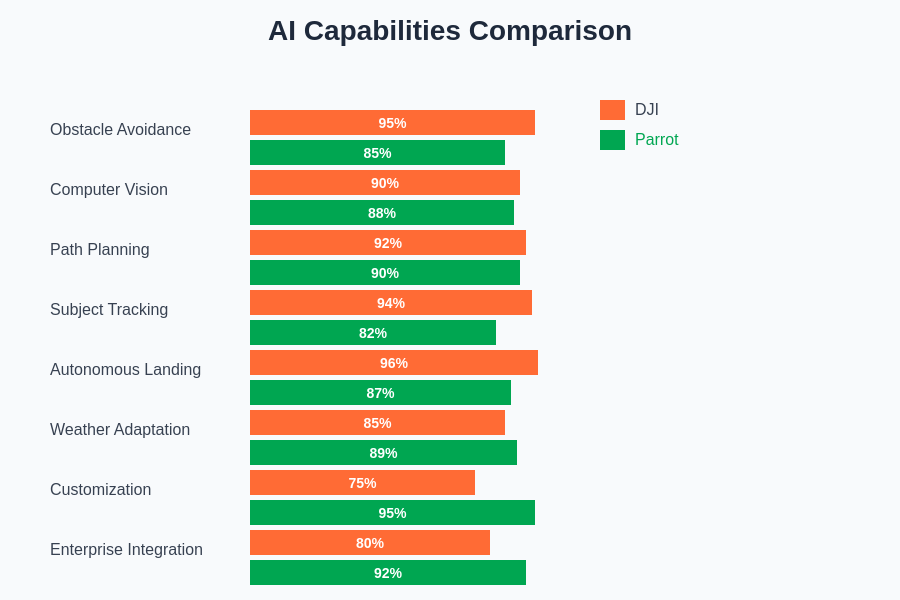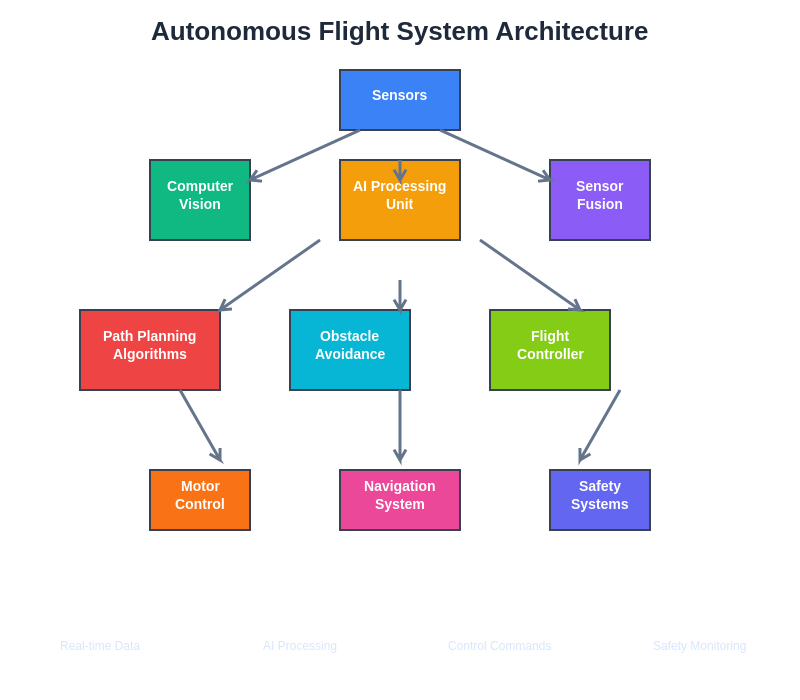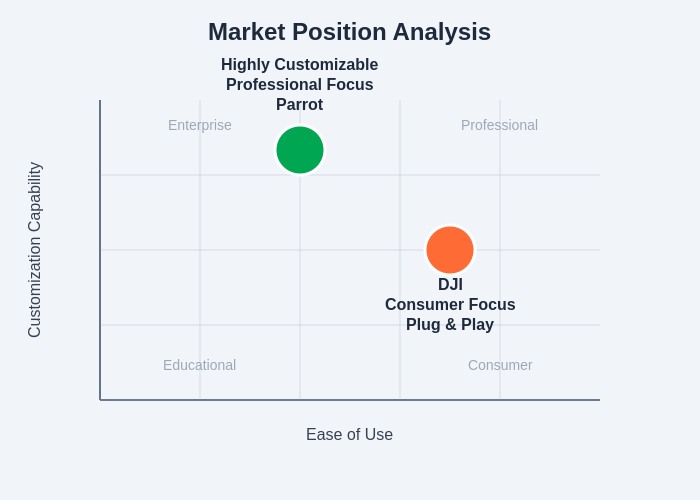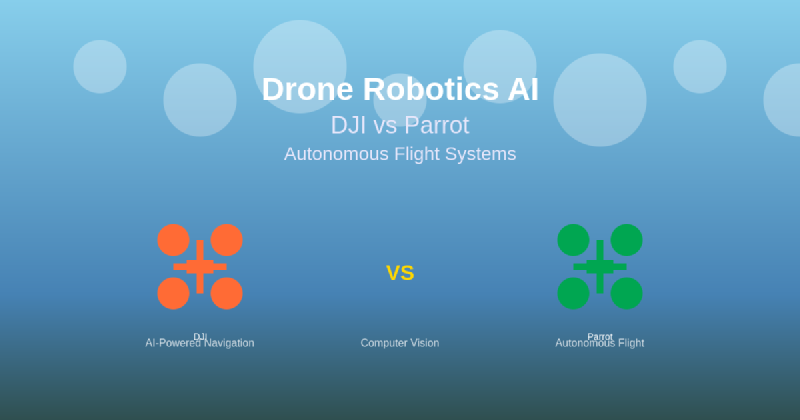The aerospace industry has witnessed a revolutionary transformation through the integration of artificial intelligence into unmanned aerial vehicle systems, fundamentally reshaping how autonomous drones perceive, navigate, and interact with their environments. At the forefront of this technological revolution stand two industry giants, DJI and Parrot, each pioneering distinct approaches to autonomous flight systems that leverage cutting-edge artificial intelligence, computer vision, and machine learning algorithms to achieve unprecedented levels of flight autonomy and operational sophistication.
Explore the latest AI trends in drone technology to understand how rapidly evolving artificial intelligence capabilities are transforming aerial robotics and autonomous navigation systems. The competition between these technological powerhouses has accelerated innovation across the entire drone industry, pushing the boundaries of what autonomous aerial systems can accomplish while making advanced robotics more accessible to commercial and consumer markets worldwide.
The Evolution of Autonomous Flight Intelligence
The journey toward truly autonomous drone flight has been marked by significant technological milestones that have progressively enhanced the intelligence and capability of unmanned aerial systems. Modern autonomous flight systems represent the convergence of multiple advanced technologies including computer vision, sensor fusion, real-time processing, and sophisticated machine learning algorithms that enable drones to make complex decisions independently while maintaining safe and efficient flight operations.
DJI has established itself as a dominant force in the consumer and professional drone market through its comprehensive approach to autonomous flight technology, integrating proprietary flight control systems with advanced obstacle avoidance capabilities and intelligent flight modes that simplify complex aerial maneuvers. The company’s investment in artificial intelligence research has resulted in sophisticated systems that can autonomously track subjects, navigate complex environments, and execute predetermined flight paths with minimal human intervention.
Parrot has carved out its niche by focusing on specialized applications and professional markets, developing autonomous flight solutions that emphasize adaptability, customization, and integration with existing enterprise systems. The French company’s approach to autonomous flight prioritizes modularity and flexibility, allowing users to customize flight behaviors and integrate third-party sensors and software solutions to meet specific operational requirements.
DJI’s Autonomous Flight Architecture
DJI’s approach to autonomous flight centers around their proprietary FlightAutonomy system, which represents a comprehensive integration of multiple sensor technologies and artificial intelligence algorithms designed to provide robust obstacle detection, intelligent flight path planning, and autonomous navigation capabilities. This system combines forward-facing stereo cameras, downward-facing cameras, ultrasonic sensors, and inertial measurement units to create a detailed three-dimensional understanding of the drone’s environment in real-time.
The company’s artificial intelligence algorithms process vast amounts of sensory data to identify potential obstacles, calculate optimal flight paths, and make split-second decisions that ensure safe autonomous operation even in complex and dynamic environments. DJI’s machine learning models have been trained on millions of flight hours and diverse environmental conditions, enabling the system to recognize and respond appropriately to a wide range of scenarios including moving obstacles, changing weather conditions, and varying lighting conditions.
Experience advanced AI capabilities with Claude for understanding complex autonomous systems and their integration with machine learning technologies. DJI’s intelligent flight modes demonstrate the practical application of artificial intelligence in consumer products, offering features such as ActiveTrack for subject following, TapFly for destination-based navigation, and intelligent return-to-home functionality that automatically navigates back to the launch point while avoiding obstacles encountered during the autonomous flight.
Parrot’s Modular Intelligence Framework
Parrot’s autonomous flight philosophy emphasizes modularity and customization, providing a flexible platform that can be adapted to meet diverse operational requirements across multiple industries and applications. The company’s ANAFI series and professional-grade platforms incorporate sophisticated artificial intelligence capabilities while maintaining an open architecture that allows for extensive customization and integration with third-party systems and sensors.
The French manufacturer’s approach to autonomous flight intelligence focuses on creating adaptable systems that can learn and evolve based on specific operational requirements and environmental conditions. Parrot’s artificial intelligence algorithms are designed to be trainable and customizable, allowing users to modify flight behaviors, adjust sensitivity parameters, and integrate specialized sensors or payloads that enhance the drone’s autonomous capabilities for specific applications.
Parrot’s emphasis on software-defined functionality means that autonomous flight capabilities can be continuously improved and expanded through software updates and algorithm refinements, providing a future-proof platform that can adapt to evolving technological requirements and operational demands. This approach has made Parrot drones particularly attractive to enterprise customers and researchers who require flexible platforms for developing custom autonomous flight solutions.
Computer Vision and Obstacle Avoidance Systems
The implementation of computer vision technology represents one of the most critical aspects of autonomous drone flight, enabling unmanned aerial vehicles to perceive and understand their three-dimensional environment with sufficient accuracy and speed to make real-time navigation decisions. Both DJI and Parrot have invested heavily in developing sophisticated computer vision algorithms that can process visual information from multiple cameras and sensors to create detailed environmental maps and identify potential obstacles.
DJI’s computer vision system utilizes advanced stereo camera arrays combined with machine learning algorithms that have been trained to recognize various types of obstacles including buildings, trees, power lines, and moving objects such as vehicles and people. The system’s ability to differentiate between static and dynamic obstacles enables more intelligent flight path planning that can predict the movement of dynamic obstacles and adjust flight trajectories accordingly.
Parrot’s computer vision approach emphasizes flexibility and adaptability, providing computer vision tools and APIs that allow developers to create custom obstacle detection and avoidance algorithms tailored to specific operational environments and requirements. This approach enables the development of specialized autonomous flight solutions for industries such as agriculture, construction, and surveillance where standard obstacle avoidance algorithms may not be sufficient for complex operational scenarios.

The comparative analysis of artificial intelligence capabilities reveals distinct strengths and strategic positioning between the two manufacturers, with DJI excelling in consumer-focused automation and reliability while Parrot demonstrates superior customization capabilities and enterprise integration flexibility.
Sensor Fusion and Environmental Perception
Modern autonomous drone systems rely on sophisticated sensor fusion techniques that combine data from multiple sensors to create comprehensive understanding of the flight environment that exceeds the capabilities of any individual sensor technology. Both DJI and Parrot have developed advanced sensor fusion algorithms that integrate visual, ultrasonic, infrared, and inertial sensor data to provide robust environmental perception capabilities that function effectively across diverse operating conditions.
DJI’s sensor fusion technology combines data from multiple camera systems, ultrasonic rangefinders, infrared sensors, and high-precision inertial measurement units to create detailed three-dimensional maps of the surrounding environment. The system’s artificial intelligence algorithms process this multi-sensor data in real-time to identify obstacles, calculate distances, and determine optimal flight paths while accounting for factors such as wind conditions, lighting variations, and environmental dynamics.
Discover comprehensive AI research capabilities with Perplexity for exploring advanced sensor technologies and their integration in autonomous systems. Parrot’s sensor fusion approach emphasizes modularity and customization, providing a flexible framework that can incorporate various sensor types and configurations depending on specific application requirements and operational environments.
Intelligent Flight Path Planning and Navigation
Autonomous flight path planning represents one of the most computationally intensive aspects of drone artificial intelligence, requiring sophisticated algorithms that can calculate optimal routes while considering multiple variables including obstacle avoidance, energy efficiency, mission objectives, and regulatory constraints. Both manufacturers have developed advanced path planning systems that demonstrate different philosophical approaches to autonomous navigation and mission execution.
DJI’s flight path planning algorithms emphasize ease of use and reliability, providing intelligent flight modes that can automatically generate and execute complex flight paths based on simple user inputs or predefined mission parameters. The system’s artificial intelligence can analyze terrain data, weather conditions, and obstacle locations to create efficient flight routes that minimize energy consumption while ensuring safe navigation throughout the entire mission.
Parrot’s approach to flight path planning focuses on flexibility and customization, providing powerful software development tools that enable users to create sophisticated autonomous flight missions tailored to specific operational requirements. The company’s path planning algorithms can be modified and optimized for particular applications, allowing for the development of specialized autonomous behaviors that may not be possible with more rigid commercial systems.
Machine Learning and Adaptive Intelligence
The integration of machine learning capabilities into autonomous drone systems has enabled the development of adaptive intelligence that can improve performance over time and learn from operational experience to enhance future flight operations. Both DJI and Parrot have incorporated various forms of machine learning into their autonomous flight systems, though their approaches differ significantly in terms of implementation and user accessibility.
DJI’s machine learning implementation focuses on improving the reliability and accuracy of autonomous flight functions through continuous algorithm refinement and training data collection from millions of flight operations worldwide. The company’s artificial intelligence systems learn from aggregate flight data to improve obstacle detection accuracy, enhance flight stability, and optimize energy consumption patterns across different environmental conditions and operational scenarios.
Parrot’s machine learning approach emphasizes user customization and application-specific training, providing tools and frameworks that allow users to train machine learning models for particular operational environments or specialized tasks. This approach enables the development of highly specialized autonomous flight capabilities that can adapt to unique operational requirements and learn from specific environmental conditions or mission parameters.
Real-Time Processing and Edge Computing
The computational requirements of autonomous flight systems demand sophisticated real-time processing capabilities that can analyze sensor data, execute artificial intelligence algorithms, and make navigation decisions within milliseconds to ensure safe and effective autonomous operation. Both manufacturers have invested in developing powerful onboard computing platforms that can handle the intensive computational demands of autonomous flight while maintaining the size, weight, and power constraints necessary for practical drone operations.
DJI’s real-time processing architecture integrates specialized processors optimized for computer vision and artificial intelligence workloads, enabling complex autonomous flight functions to be executed entirely onboard the aircraft without requiring external computing resources or network connectivity. This approach ensures reliable autonomous operation even in environments where communication links may be unreliable or unavailable.
Parrot’s edge computing strategy emphasizes modularity and upgradeability, providing computing platforms that can be customized and expanded to meet specific computational requirements for specialized autonomous flight applications. The company’s approach allows users to integrate additional processing power or specialized computing hardware to support custom artificial intelligence algorithms or computationally intensive applications.

The architectural framework of modern autonomous flight systems demonstrates the complex integration of multiple subsystems and artificial intelligence components that must work seamlessly together to achieve reliable autonomous operation across diverse environmental conditions and operational requirements.
Safety Systems and Fail-Safe Mechanisms
Autonomous flight systems must incorporate comprehensive safety mechanisms and fail-safe procedures that can detect system failures, respond to emergency situations, and ensure safe aircraft recovery even when primary autonomous systems are compromised. Both DJI and Parrot have developed sophisticated safety architectures that provide multiple layers of protection and emergency response capabilities.
DJI’s safety systems include redundant sensor arrays, automatic return-to-home functionality, low battery protection, and intelligent emergency landing procedures that can safely recover the aircraft even when primary navigation systems fail. The company’s artificial intelligence algorithms continuously monitor system health and can automatically adjust flight parameters or initiate emergency procedures when potential safety issues are detected.
Parrot’s safety approach emphasizes customizable safety protocols that can be adapted to meet specific operational requirements and regulatory constraints. The company’s safety systems provide flexible frameworks that allow users to implement custom safety procedures and fail-safe mechanisms appropriate for particular operational environments or mission-critical applications.
Commercial and Industrial Applications
The autonomous flight capabilities developed by both DJI and Parrot have enabled a wide range of commercial and industrial applications that leverage artificial intelligence to automate complex aerial operations and provide valuable data collection and analysis capabilities. These applications demonstrate the practical value of autonomous drone technology across diverse industries and operational scenarios.
DJI’s commercial drone solutions emphasize ease of deployment and operational efficiency, providing autonomous flight capabilities that can be quickly implemented across various industries including construction, agriculture, public safety, and infrastructure inspection. The company’s artificial intelligence systems enable automated data collection, analysis, and reporting that can significantly improve operational efficiency and decision-making processes.
Parrot’s commercial focus emphasizes customization and integration, providing platforms that can be adapted to meet specific industry requirements and integrated with existing operational systems and workflows. The company’s autonomous flight solutions are particularly popular in specialized applications such as precision agriculture, surveying, and research where custom autonomous behaviors and sensor integration are essential for operational success.
Performance Metrics and Comparison Analysis
Evaluating the performance of autonomous drone systems requires consideration of multiple factors including flight stability, obstacle avoidance accuracy, battery efficiency, operational range, and system reliability across various environmental conditions and operational scenarios. Both DJI and Parrot have achieved impressive performance levels in their respective market segments, though their systems excel in different areas based on their design philosophies and target applications.
DJI’s autonomous flight systems consistently demonstrate exceptional reliability and ease of use, with industry-leading obstacle avoidance accuracy and flight stability that makes their platforms suitable for a wide range of users from beginners to professional operators. The company’s artificial intelligence algorithms provide consistent performance across diverse environmental conditions and operational scenarios.
Parrot’s autonomous flight systems excel in flexibility and customization capabilities, providing superior adaptability for specialized applications and complex operational requirements. The company’s platforms offer exceptional integration capabilities and customization options that enable the development of highly specialized autonomous flight solutions for unique operational environments and mission requirements.

The strategic market positioning of both manufacturers reflects their distinct approaches to autonomous flight technology, with DJI focusing on ease of use and consumer accessibility while Parrot emphasizes customization capabilities and professional applications that require specialized autonomous flight behaviors.
Future Technological Developments
The continued evolution of autonomous drone technology promises even more sophisticated artificial intelligence capabilities, enhanced sensor technologies, and improved integration with broader autonomous systems and smart infrastructure. Both DJI and Parrot are actively investing in research and development initiatives that will shape the future of autonomous flight technology and expand the capabilities of unmanned aerial systems.
Emerging technologies such as 5G connectivity, advanced edge computing, swarm intelligence, and integrated air traffic management systems will enable new levels of autonomous flight sophistication and coordination. These developments will facilitate more complex autonomous missions, improved safety systems, and seamless integration with smart city infrastructure and autonomous transportation networks.
The integration of artificial intelligence into drone systems represents just the beginning of a broader transformation in aerial robotics that will enable unprecedented levels of automation, intelligence, and operational capability. The continued competition between industry leaders like DJI and Parrot will drive innovation and accelerate the development of technologies that make autonomous flight more accessible, reliable, and capable across an ever-expanding range of applications and operational environments.
Disclaimer
This article is for informational purposes only and does not constitute professional advice regarding drone operations, autonomous flight systems, or artificial intelligence technologies. The views expressed are based on current understanding of drone technology and autonomous flight capabilities. Readers should conduct their own research, consult with qualified professionals, and comply with applicable regulations when implementing autonomous drone systems. Performance characteristics and capabilities may vary depending on specific models, environmental conditions, and operational parameters.
